Native Milkweeds
One of the most effective ways to support monarch butterflies is to plant native milkweeds.
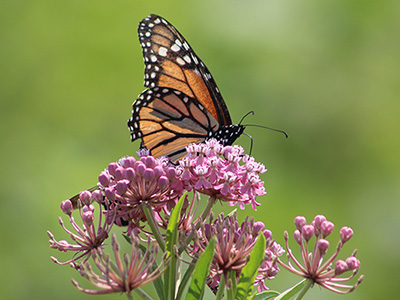
Anna Weyers, USFWS.
As the larval host plants for these beneficial insects, native milkweeds make a wonderful addition to butterfly gardens. They serve as food and provide habitat, creating a safe haven on the monarch migration route. These flowering plants also provide nectar for other pollinators and play an important role in the local ecosystem. There are currently six commercially available species of native milkweeds in Florida, which can be planted for both visual appeal as well as invertebrate conservation.
Swamp Milkweed (Asclepias incarnata)
Swamp milkweed is a native perennial that not only attracts monarch butterflies, but also caters to the related queen and soldier butterflies, all relying on the leaves to feed their young. It’s a perfect addition to any pollinator garden, with small, fragrant rose-purple flowers that bloom June through October. Swamp milkweed can be grown in hardiness zones 3a through 9b, reaching a height of 2 to 4 feet and a spread of 1 to 3 feet. This milkweed species needs full or part shade with slightly moist to wet soil.
Pinewoods Milkweed (Asclepias humistrata)
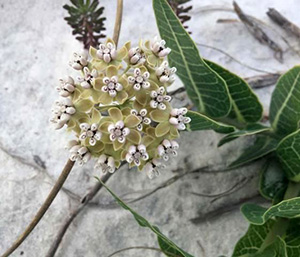
Pinewoods milkweed, also known as sandhill milkweed, is a deciduous perennial found on Florida’s dunes, sandhills and roadsides. It also thrives in gardens located in hardiness zones 8a through 9b, with the added benefit of being drought tolerant. Monarch butterflies feed on its leaves, and other pollinators such as bees and moths visit the plant as well. This milkweed grows less than 3 feet tall with a sprawling growth pattern. Clustered white to pink to lavender blooms appear in the spring and summer. The leaves are also colorful, with pink to purple veins. This native grows best in sunny conditions with sandy, well-drained soil.
Aquatic Milkweed (Asclepias perennis)
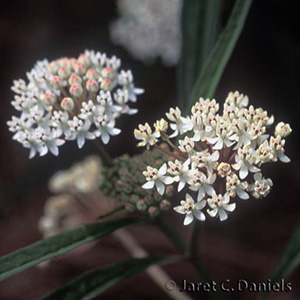
Aquatic milkweed, also called white swamp milkweed, is another host plant for monarch, queen and soldier butterflies. It sports small white flowers that bloom May through September. Aquatic milkweed is a low-growing plant, reaching 1 to 2 feet tall and 1 to 3 feet wide. This native perennial grows in hardiness zones 8b through 9b and requires sandy soil that is slightly moist to wet. Unlike pinewoods milkweed, this plant has low drought tolerance, so be sure to water during dry spells. This is a shade-loving species that can also tolerate partial sun conditions.
Butterflyweed (Asclepias tuberosa)
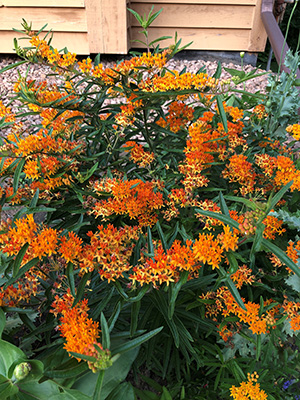
Butterflyweed offers a bright pop of color to the landscape during the blooming period, July to September. This species is not to be confused with tropical milkweed (Asclepias curassavica), which looks quite similar. The easiest way to tell them apart is the color differentiation; butterflyweed has orange-yellow flowers with some red on the petals, while tropical milkweed has red flowers with some yellow coloration. In Florida this native perennial is hardy in zones 8 through 10 and prefers full sun or partial shade, with a moderate drought tolerance. Unlike some of the other milkweed species, it performs well in almost any soil type. It grows quickly, reaching 2 to 3 feet in height and width. Butterflyweed is often stripped of its leaves by caterpillars; many gardeners will intersperse the plantings with other, shorter species to allow the colorful blooms to stand out, letting the shorter plants cover up butterflyweed’s bare stems.
Whorled Milkweed (Asclepias verticillata)
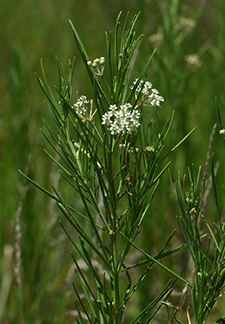
Named for the pattern in which its leaves grow from the stem, whorled milkweed is found in woodlands and sandhills in the eastern U.S. This perennial is a favorite of bees and butterflies, particularly the monarchs. From May to September, you can spot its small white flowers clustered along the stems. This native species is relatively easy to grow and stands out with its resistance to deer and drought. Hardy in zones 4a to 9b, whorled milkweed should be planted in full sun or partial shade, preferably in moist soil with good drainage. This small plant reaches 1 to 2.5 feet in height and 1 to 2 feet in width.
Green antelopehorn (Asclepias viridis)
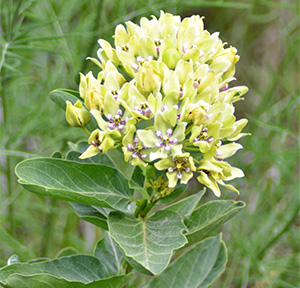
Add unique flair to your milkweed garden with the green antelopehorn, which features green or purple flowers in the spring and summer. This perennial is found in the central and eastern-central United States, hardy in zones 4a to 9b. Its nectar and leaves attract bees, butterflies, hummingbirds, moths and other pollinators. Similar to other milkweed species, it’s an important food source for the monarch butterfly caterpillar. Its small stature puts it at about 1.5 to 2.5 feet tall and 1 to 2 feet wide. Green antelopehorn should be planted in full sun with well-drained or occasionally dry soil.
Whether you are looking to establish or expand a butterfly or pollinator garden, native milkweed is an excellent way to attract beneficial insects and wildlife. While witnessing a monarch butterfly is a wonderful experience, planting native milkweed is also a chance to take part in a critical movement to restore and support butterfly populations. For more questions on native milkweeds, contact your county Extension office.
Also on Gardening Solutions
More from UF/IFAS
- Aquatic Milkweed–UF/IFAS Extension Santa Rosa County (PDF)
- Monarch and Milkweeds–Florida Museum (PDF)
- Monarchs and Milkweed: You Can Help–UF/IFAS Blogs Columbia County
- Native Habitats for Monarch Butterflies in South Florida
- Pinewoods Milkweed–CAIP Plant Directory
- Queen butterfly, Danaus gilippus–Florida Museum
- Sandhill Milkweed (Pinewoods Milkweed), Asclepias humistrata
- Swamp Milkweed–UF/IFAS Extension Santa Rosa County (PDF)
